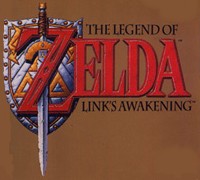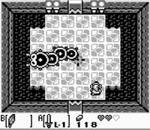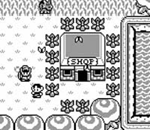|
|

|
PLATFORM
|
GBC
|
BATTLE SYSTEM
|

|
INTERACTION
|

|
ORIGINALITY
|

|
STORY
|

|
MUSIC & SOUND
|

|
VISUALS
|

|
CHALLENGE
|
Easy
|
COMPLETION TIME
|
Less than 20 Hours
|
|
OVERALL

|
+ Solid gameplay.
+ Good soundtrack and graphics.
- A bit light on story.
|
Click here for scoring definitions
|
|
|
After Link saves Hyrule from Ganon, he sails across the seas to face further threats, although a storm destroys his vessel, after which he awakens on Koholint Island. There, he is taken to the house of a man named Tarin and his daughter Marin, with a mysterious owl telling Link that he must awaken the Wind Fish, the guardian of Koholint, via eight instruments of the Sirens, in order to return home. Nintendo's The Legend of Zelda: Link's Awakening for the Gameboy was the first portable installment of the series, initially released in 1993 but enhanced and re-released years later for the Gameboy Color. Link's Awakening is an enjoyable experience, and a definitive installment of the series, to boot.
Link's Awakening mostly retains the top-down perspective from A Link to the Past during overworld and dungeon exploration, although there are some occasional side-scrolling passageways in dungeons. The player can assign the various tools Link acquires during his quest to the A and B buttons, among them being his sword and shield, the former allowing him to attack enemies (with a handy charge-and-swirl attack and simply holding the sword out charged able to damage foes, as well), and the latter he can use to block most enemy attacks (and this time, shield-blocking doesn't occur automatically).
Link acquires other tools, as well, such as a bow and arrows, bombs, and, more interestingly, a feather allowing him to jump, which can definitely broaden his exploration of the world and dungeons, not to mention aid in combat. Bosses at the end of dungeons provide Link with an additional heart container to lengthen his health, which collecting four heart pieces across the world can do, as well. As with before, moreover, normal enemies drop an array of random goods when defeated, such as recovery hearts, rupees, arrows, bombs, and so forth.
 A familiar boss
A familiar boss
|
|
Combat, fortunately, never detracts from overworld and dungeon exploration, and bosses at the end of dungeons, as with before, require some semblance of strategy to defeat. The game lacks consumable healing items, although it is possible to purchase a special potion that completely restores Link's health when he loses all his life, providing some room for error should bosses prove to be formidable. All in all, the battle system preserves all that was good about that in A Link to the Past, even somewhat building upon it.
The interface is fairly easy and non-problematic as the player changes Link's tools, with helpful maps of the overworld and dungeons, along with a new feature in dungeons once players acquire a compass, where a tone plays if a room has a key. The Gameboy Color version of the game has some added features such as a secret dungeon and a sidequest where a mouse takes pictures of Link at various locations. There are some points where the player may have to take notes to revisit certain areas, some of which are necessary to advance the game, but otherwise, interaction in Link's Awakening is more than adequate.
Link's Awakening retains elements from previous Zeldas to make it feel like a logical continuation of the franchise, such as Link and the use of tools to advance the game, although it did mix up the series formula somewhat by letting the player assign different tools to different buttons and not stick with Link's sword and shield, and the game itself features a setting other than Hyrule, making it feel sufficiently fresh.
 A shopkeeper who doesn't know how to care for his lawn
A shopkeeper who doesn't know how to care for his lawn
|
|
The story, however, isn't as much of a driving factor as the game's other aspects, and since Link's Awakening takes place outside Hyrule, the plot is relatively unimportant to the series as a whole, although there is a major plot twist involving the game's setting. The translation is competent, if slightly odd at times, and ultimately, while the story isn't a reason to play the game, it's by no means a burden.
The sound quality of Link's Awakening is well above average, with reasonably diverse, fitting sound effects for a Gameboy title, not to mention a varied soundtrack, with each dungeon, for instance, having its own distinct theme, in addition to the overworld theme heard in most Zelda titles. There are a few annoying themes, but the sound is certainly a draw to the game.
The visuals look nice, as well, with the DX version making decent use of the Gameboy Color's hues, with environments being reasonably diverse, along with character and monster sprites, even if the former are a bit disproportionate. Still, the graphics hardly detract from the game.
As with most Zeldas, finally, the game is somewhat short, with experienced gamers able to clear it in eight hours or less, and inexperienced gamers sure to take longer. All in all, The Legend of Zelda: Link's Awakening was a worthy addition to the series, evolving the franchise's formula somewhat but still preserving its entertainment value, with solid gameplay, sound, and graphics. Story, as would be the case with future installments, is still lax, but as this installment was a solid beginning for portable Zelda games, it definitely deserves more than a look.
Review Archives
|









